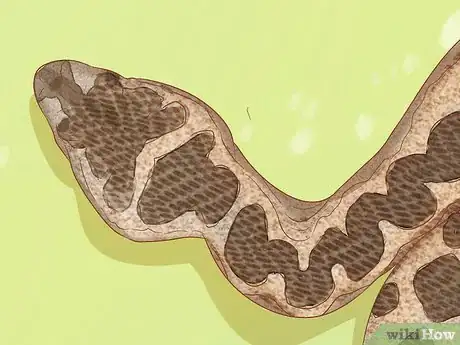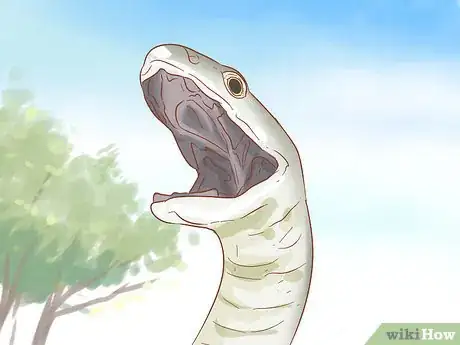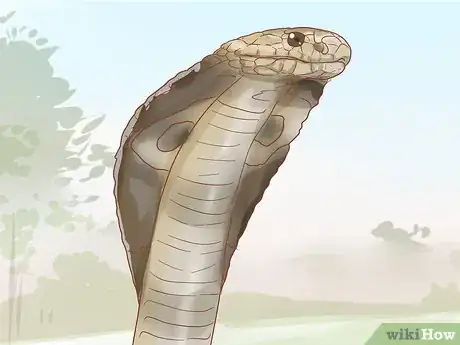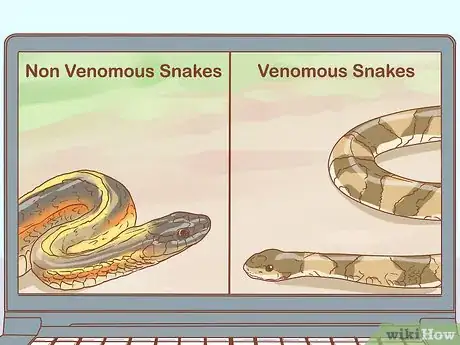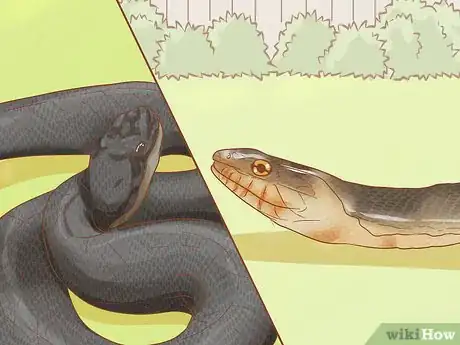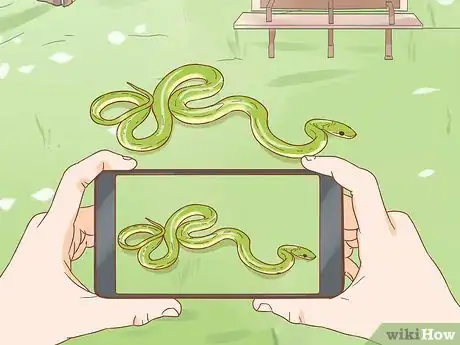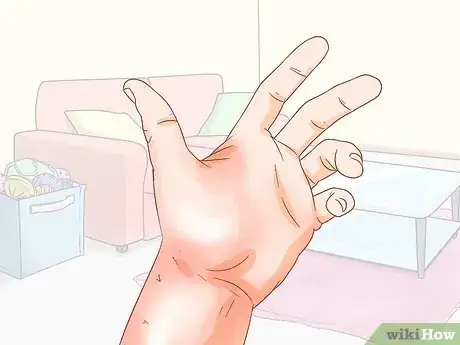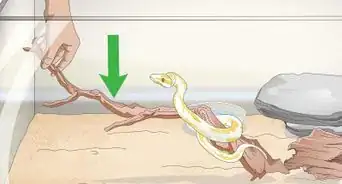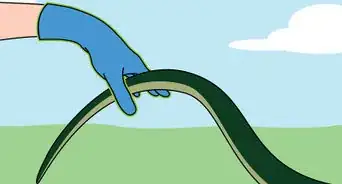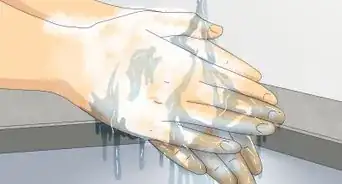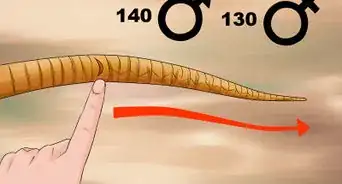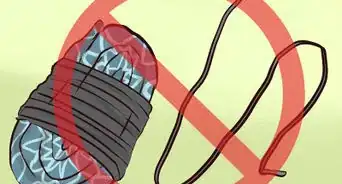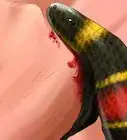This article was co-authored by wikiHow staff writer, Megaera Lorenz, PhD. Megaera Lorenz is an Egyptologist and Writer with over 20 years of experience in public education. In 2017, she graduated with her PhD in Egyptology from The University of Chicago, where she served for several years as a content advisor and program facilitator for the Oriental Institute Museum’s Public Education office. She has also developed and taught Egyptology courses at The University of Chicago and Loyola University Chicago.
There are 15 references cited in this article, which can be found at the bottom of the page.
wikiHow marks an article as reader-approved once it receives enough positive feedback. This article received 12 testimonials and 84% of readers who voted found it helpful, earning it our reader-approved status.
This article has been viewed 548,587 times.
Learn more...
Encountering a snake in the wild can be alarming, especially if you’re not sure what species it is. A bite from a venomous snake can be deadly. The best way to know whether you’re dealing with a venomous or non-venomous snake is to get familiar with the kinds of snakes that live in your area. You can also look for characteristics associated with common venomous species. If you get bitten by any kind of snake, it’s important to seek medical attention immediately.
Steps
Identifying Common Venomous Snakes
-
1Look for a triangular head to identify a viper. In the U.S., the most common venomous snakes are pit vipers. These snakes have large, triangular heads that are widest at the base and significantly wider than the neck.[1] They also have a pit on their faces between the eye and nostril, which senses heat and makes it easier for them to locate their prey.[2] To spot a pit viper, look for a triangular head shape, a pit on the face, and vertical, cat-like pupils.
- Pit vipers are also found in Europe, Asia, Africa, and across the Americas.
- Pit viper species found in North America include a variety of rattlesnakes as well as water moccasins (also known as cottonmouth snakes).
Warning: Not all snakes with triangular heads are venomous, and there are also a variety of venomous species with narrow heads and round pupils. Don’t rely entirely on these features to identify a venomous snake![3]
-
2Identify a rattlesnake by its rattle or button. Rattlesnakes are a type of pit viper, and the most common type of venomous snake in the Americas. Aside from their triangular heads and heavy bodies, their most distinguishing feature is the rattle on the end of their tails. In some cases they may have only a button (a single rattle segment) or a squared-off tail if they have lost their rattle.[4]
- It is also helpful to learn the different colors and patterns associated with different rattlesnake species. For example, diamondback rattlesnakes, as their name suggests, have a distinctive diamond pattern along their backs.
Advertisement -
3Recognize coral snakes by their colors. Coral snakes are a type of brightly colored venomous snake found in the Americas and some parts of Asia and the Pacific. These snakes are not pit vipers—they have small, slightly rounded heads and their eyes have round pupils. While their colors and patterns vary, you can typically identify them by looking for bright red, yellow, and black bands.[5]
- If you live in the Southeastern U.S., you might have heard the saying “Red touch yellow, kill a fellow. Red touch black, a friend of jack.” This is a useful rhyme for remembering the difference between venomous coral snakes and harmless king snakes—king snakes do not have bands of red and yellow together.
- However, there are other non-venomous snakes with touching red and yellow bands, so this little rhyme is not always reliable.[6]
-
4Check for a blue-black mouth to spot a black mamba. If you live or travel in Sub-Saharan Africa, you might encounter the deadly black mamba. These snakes are long (up to 14 feet (4.3 m)) and are olive or grey in color. You can recognize a black mamba by the distinctive blue-black color of the inside of its mouth, which it might show off if it feels frightened or threatened.[7]
- Mambas are related to cobras, and they behave similarly when threatened. If you corner a black mamba, it may rear up and open a hood or flap around its neck.
- Like coral snakes and cobras, black mambas are elapids, not vipers. They have narrow heads and round pupils.
-
5Watch for a hood to identify a cobra. These famous venomous snakes are found in parts of Asia, Africa, and the Pacific. The most distinguishing feature of the cobra is the hood around its head and neck, which it displays when it feels threatened, along with a loud and intimidating hiss. Some cobras are also able to spray venom at their attackers.[8]
- You can also recognize some cobras by their distinctive patterns. For example, the Indian cobra has a pair of connected eye spots on the back of its hood that resemble spectacles.
-
6Familiarize yourself with the venomous snakes in your area. There are numerous species of venomous snakes around the world, and there’s no single set of distinguishing features you can use to tell if a snake is venomous. The best way to know for sure if a snake is venomous is to look it up based on its appearance, behavior, and geographic region.[9] Do a search online or look at a local reptile guide to find out what kinds of venomous snakes—if any—live in your area.
- For example, if you live in Oregon, the only venomous snake you are likely to encounter is the western rattlesnake.[10]
- Just like with venomous snakes, there’s no set of distinguishing features that indicates that a snake is not venomous.[11] To identify non-venomous snakes, look at a local reptile guide to find out which snakes live in your area and study their specific characteristics.
-
7Learn to distinguish between similar-looking species. Some non-venomous snakes can be quite difficult to distinguish from similar-looking venomous species. If there are easily confused species in your area, study each type so that you can learn some of their distinguishing characteristics.
- For example, the venomous North American water moccasin, or cottonmouth, is often confused with a harmless water snake. You can tell the difference by looking at the shape of the snake’s head and body. Water moccasins have heavy bodies and triangular heads, while water snakes are slender, with narrow heads.[12]
- People often confuse gopher snakes, which are not venomous, with rattlesnakes, due to their similar coloration and aggressive behavior. However, unlike rattlesnakes, gopher snakes have a pointed tail without rattles.[13]
-
8Get a picture of any snakes you see for reference if possible. If you happen to see a snake and you’re wondering what kind it is, try to snap a picture of it with your phone or camera. You can then show the picture to an expert at a local government wildlife agency, or use it as a guide to help you look up the snake based on its features.[14]
- Don’t put yourself in danger trying to get a good picture! Just try to get a shot from a safe distance if you can.
- If you don’t have a picture to work with, you can use Google Image Search to try to find pictures of similar snakes. For example, use search terms like “black snake yellow ring neck Pennsylvania,” and you will turn up images of the Northern ring-necked snake.
Recognizing Snake Bite Symptoms
-
1Seek emergency care if you’re bitten by a snake. If you’re bitten by any snake—even if you’re pretty sure it’s not venomous—go to the emergency room or call emergency services immediately. Even non-venomous snake bites can be dangerous if left untreated.[15]
- While you’re waiting for help, wash the bite with soap and water if you can, and keep the bite below the level of your heart. Remove any tight clothing, watches, or jewelry that might constrict the area and cause swelling.
-
2Watch for severe symptoms to identify a venomous bite. After being bitten by a snake, make note of any symptoms that develop. Let emergency medical personnel or your doctor know about these symptoms, as they can help your care team figure out what type of venom they may be dealing with and how to treat it. Common symptoms of a venomous snake bite include:[16]
- Severe pain, redness, swelling, or bruising around the bite
- Numbness around the face or mouth
- Difficulty breathing
- A rapid heartbeat
- Weakness
- Dizziness, lightheadedness, or fainting
- A headache
- Nausea or vomiting
- Blurred vision
- Fever
- Convulsions
Caution: While 2 distinctive fang marks are typical of many venomous snake bites, not all snakes deliver their venom that way.[17] Don’t rely on the appearance of the bite alone to tell you whether or not it is venomous.
-
3Look out for mild pain, itching, and swelling with a non-venomous bite. If you’ve been bitten by a non-venomous snake, your symptoms will likely be fairly mild. However, it’s still important to have the bite checked out by a doctor immediately. Untreated snake bites of any kind can lead to a serious infection, and some people may experience allergic reactions to the snake’s saliva. Common symptoms of a non-venomous bite include:[18]
- Pain in the area of the bite
- Mild redness and swelling
- Bleeding from the bite wound
- Some itching in the bite area
Warnings
- A bite from even a non-venomous snake can become infected. Always seek medical attention and try to positively identify the animal that bit you.⧼thumbs_response⧽
- If you don't seek medical help right away after getting bitten by a venomous snake, it can lead to death.⧼thumbs_response⧽
- Never try to grab any wild snake. If you are sure the animal is non-venomous and insist on handling it, do so in a non-threatening manner. A snake stick is a great tool when used safely.⧼thumbs_response⧽
- Do not try to handle a snake that is hissing, rattling its tail, curving its neck into an S shape, or spitting, because that is them giving you a warning to leave them alone or they will strike.[22]⧼thumbs_response⧽
References
- ↑ https://www.medicalnewstoday.com/articles/324007.php
- ↑ https://www.noble.org/news/publications/ag-news-and-views/2008/june/learn-to-recognize-venomous-snakes/
- ↑ https://www.mcgill.ca/oss/article/did-you-know-general-science/fake-snake-news-how-not-identify-poisonous-snake
- ↑ https://www.noble.org/news/publications/ag-news-and-views/2008/june/learn-to-recognize-venomous-snakes/
- ↑ https://www.livescience.com/43938-coral-snakes-colors-bites-farts-facts.html
- ↑ http://www.reptilesmagazine.com/Herp-Queries-Red-Touch-Yellow-Kill-A-Fellow-Doesnt-Always-Work/
- ↑ https://www.nationalgeographic.com/animals/reptiles/b/black-mamba/
- ↑ https://animals.sandiegozoo.org/animals/cobra
- ↑ https://www.mcgill.ca/oss/article/did-you-know-general-science/fake-snake-news-how-not-identify-poisonous-snake
- ↑ https://www.dfw.state.or.us/wildlife/living_with/docs/livingwsnakes.pdf
- ↑ https://www.mcgill.ca/oss/article/did-you-know-general-science/fake-snake-news-how-not-identify-poisonous-snake
- ↑ http://ufwildlife.ifas.ufl.edu/water_moccasin_watersnake_comparison.shtml
- ↑ https://www.dfw.state.or.us/wildlife/living_with/docs/livingwsnakes.pdf
- ↑ http://npic.orst.edu/pest/snake.html
- ↑ https://www.medicalnewstoday.com/articles/324007.php
- ↑ https://www.medicalnewstoday.com/articles/324007.php
- ↑ https://www.sciencedaily.com/releases/2011/05/110516121728.htm
- ↑ https://www.medicalnewstoday.com/articles/324007.php
- ↑ https://www.medscape.com/answers/168828-39085/what-percentage-of-snake-species-are-venomous
- ↑ https://www.ncbi.nlm.nih.gov/pmc/articles/PMC4891849/
- ↑ https://www.ncbi.nlm.nih.gov/pmc/articles/PMC4123280/
- ↑ http://vetmed.tamu.edu/news/pet-talk/reptile-emotions
About This Article
To differentiate between poisonous and non-poisonous snakes, look for common venomous snake features, like a triangular shaped head, bright colors, or a rattle on the end of the tail, which indicates a poisonous rattlesnake. You can also check for a pit between the nostrils and the eyes, or a hood around the head and neck, which are both characteristics of poisonous snakes. It's best to research common species that live in your area so you can spot poisonous snakes that you're likely to cross paths with! To learn about exceptions to these tips, including which colorful snakes aren’t poisonous, read on!
